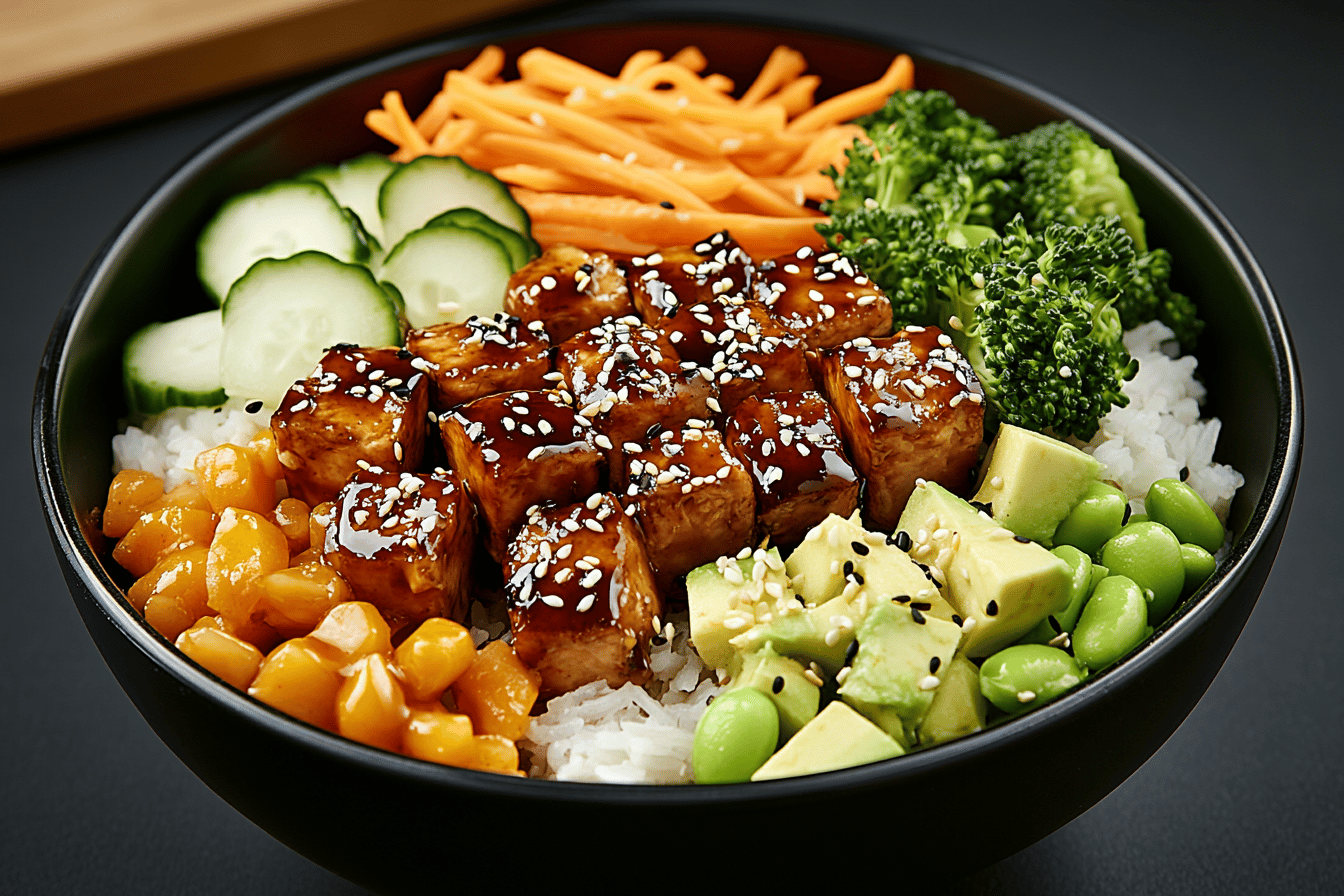Superfood Bowl Japanese Style
Introduction
A Superfood Bowl in the Japanese style offers a vibrant, nutritious, and satisfying way to indulge in plant-based cuisine. This wholesome dish, inspired by the flavors of Japan, combines fresh vegetables, hearty grains, savory sauces, and other nutrient-packed ingredients to create a balanced and delicious meal. Perfect for anyone looking to add more superfoods to their everyday diet, this bowl is as visually appealing as it is healthy and flavorful. Let’s dive into the ingredients and steps to create your very own Superfood Bowl in the Japanese style!
Detailed Ingredients with Measures
Ingredients for the Bowl
– Half a cup of cooked quinoa
– One medium-sized avocado, sliced
– One small cucumber, thinly sliced
– Two small carrots, julienned
– Half a cup of edamame beans, cooked and shelled
– One handful of mixed leafy greens
Ingredients for the Dressing
– Two tablespoons of soy sauce
– One tablespoon of rice vinegar
– Two teaspoons of sesame oil
– One teaspoon of grated fresh ginger
– One teaspoon of maple syrup or a sweetener of choice
Toppings
– One tablespoon of sesame seeds
– A small handful of crushed nori sheets or seaweed flakes
– A sprinkle of chili flakes (optional)
Prep Time
The preparation for this Superfood Bowl takes approximately 10 minutes, especially if you have your quinoa pre-cooked and your ingredients are readily available. This ensures a quick and convenient recipe for anyone pressed for time but still wanting wholesome flavors.
Cook Time, Total Time, Yield
Cook time is minimal, as the only cooking required is the preparation of quinoa and edamame beans, which can be done in about 10–15 minutes. Combined with the preparation time, the total time to assemble this nutritious bowl is around 20–25 minutes. This recipe yields one serving but can easily be doubled or adjusted to meet your needs.
Enjoy this simple and delightful Superfood Bowl, perfectly suited for a quick lunch, light dinner, or energizing meal anytime.
“`html
Detailed Directions and Instructions
Step 1: Prepare the Rice
1. Rinse the rice thoroughly until the water runs clear to remove any excess starch.
2. Cook the rice according to the package instructions. Typically, a 1:2 ratio of rice to water is used.
3. Once cooked, let the rice cool slightly and set aside.
Step 2: Prepare the Toppings
1. Wash all the fresh vegetables and fruits thoroughly.
2. Slice the avocado and mango into thin, uniform slices and set them aside.
3. Grate the carrots and cut the cucumber into thin sticks or slices as desired.
4. Chop the red cabbage into fine strips and steam or lightly cook it if preferred. Alternatively, serve it raw for added crunch.
Step 3: Prepare the Edamame
1. Boil water in a pot and cook the edamame beans for 3-5 minutes until tender.
2. Drain the cooked edamame and season lightly with salt if desired.
Step 4: Make the Dressing
1. In a small bowl, whisk together soy sauce, lime juice, sesame oil, and a sweetener of your choice (such as maple syrup or agave).
2. Taste the dressing and adjust seasoning if needed. Add a pinch of chili flakes or a dash of wasabi for a spicy kick.
3. Set the dressing aside until the bowl assembly is ready.
Step 5: Assemble the Japanese Superfood Bowl
1. Start by adding the cooked rice to the base of your serving bowl.
2. Arrange the toppings around the rice in sections. Place the sliced avocado, mango, grated carrot, cucumber, red cabbage, and edamame in neat piles for a visually appealing layout.
3. Scatter your chosen toppings like sesame seeds, nori strips, and microgreens over the bowl for added texture and flavor.
4. Drizzle the prepared dressing evenly over the entire bowl.
Step 6: Serve the Bowl
1. Serve immediately while fresh, ensuring all components are evenly dressed.
2. For leftovers, keep the bowl components and dressing separate. Store each ingredient in an airtight container in the refrigerator.
Notes
Note 1: Substitution Options
– Replace white rice with brown rice, quinoa, or cauliflower rice for a different base.
– Substitute any vegetable or fruit topping based on your personal preference or seasonal availability.
Note 2: Enhancing the Flavor
– Garnish the bowl with additional soy sauce or sriracha for extra flavor.
– Add roasted seaweed or pickled ginger for authentic Japanese-inspired taste.
Note 3: Meal Prep Tips
– Prepare the toppings in advance and store them separately to assemble fresh bowls throughout the week.
– Double the dressing recipe and keep it stored in an airtight container for quick meals.
Note 4: Dietary Adjustments
– To make the recipe gluten-free, use tamari instead of soy sauce.
– For additional protein, consider adding tofu, tempeh, or plant-based protein alternatives.
“`
Cook techniques
Prepare the base first
Begin with the preparation of your chosen rice base (e.g., sushi rice or mixed grain rice). Focus on cooking your rice properly so it achieves the ideal consistency – fluffy, yet firm.
Marinate the tofu
Cut the tofu into small cubes and marinate them thoroughly in a mix of soy sauce, rice vinegar, sesame oil, and spices to infuse them with a burst of flavor.
Roast or cook components individually
Cook or roast vegetables, seaweed, or protein in separate portions to ensure each component retains its individual texture and flavor.
Layer the ingredients thoughtfully
Layer your cooked rice as the base, and place each ingredient in clusters on top, ensuring the visual appeal of a balanced bowl.
Focus on garnishing and sauce
Use sauces like soy sauce or tahini, sprinklings of sesame seeds or herbs, and add textures like crunchy nuts or seeds as your final touches.
FAQ
Can I substitute rice with other grains?
Yes, feel free to use alternatives like quinoa or barley if desired.
What type of tofu works best?
Firm or extra-firm tofu is recommended as it holds its shape well during marination and cooking.
Is it necessary to include seaweed?
Seaweed adds an authentic Japanese-style flavor but can be replaced or omitted based on your preference.
How can I make the dish gluten-free?
Use gluten-free soy sauce or tamari as a substitute to make the meal gluten-free.
What can I use to garnish the bowl?
You can use sesame seeds, fresh herbs, or crunchy toppings like roasted nuts for added flavor and texture.

Conclusion
The Superfood Bowl in Japanese style is a harmonious blend of nutritious ingredients and exotic flavors. It combines health benefits with a delightful taste profile, making it a perfect choice for anyone looking for a wholesome and delicious meal. With its vibrant colors and satisfying components, this dish not only nourishes your body but also brings joy to your dining experience. Let this recipe inspire you to explore new combinations and savor the rich flavors of plant-based cuisine.
More recipes suggestions and combination
Quinoa and Roasted Vegetable Buddha Bowl
Try this hearty and colorful dish featuring roasted vegetables and protein-rich quinoa, complemented by a creamy tahini dressing.
Avocado and Sesame Rice Bowl
Combine creamy avocado slices with warm sesame-flavored rice, topped with fresh veggies for a balanced meal option.
Edamame and Seaweed Salad Bowl
Mix steamed edamame beans with a seaweed salad, adding a touch of miso dressing for a refreshing and light meal.
Japanese Tofu Ramen Bowl
Savor a comforting bowl of ramen noodles topped with crispy tofu, mushrooms, and a flavorful soy-based broth.
Sweet Potato and Spinach Power Bowl
Roast sweet potatoes and combine them with fresh spinach, chickpeas, and a zesty lemon dressing for an energizing meal.
Teriyaki Veggie Stir-Fry Bowl
Create a quick and tasty meal with stir-fried vegetables glazed in teriyaki sauce and served over steamed rice or noodles.
Sushi-Inspired Rice Bowl
Recreate sushi flavors with seasoned rice, fresh cucumber, shredded nori, and your favorite plant-based toppings.







